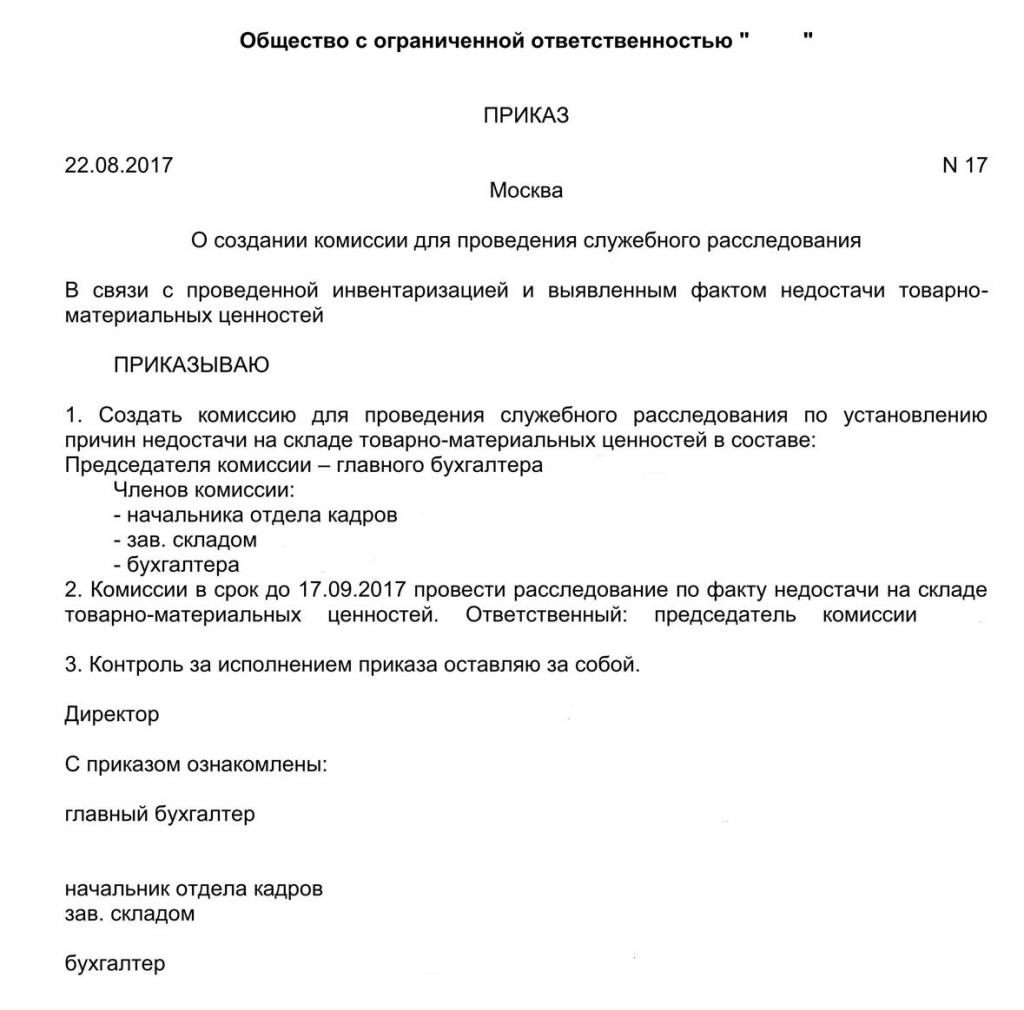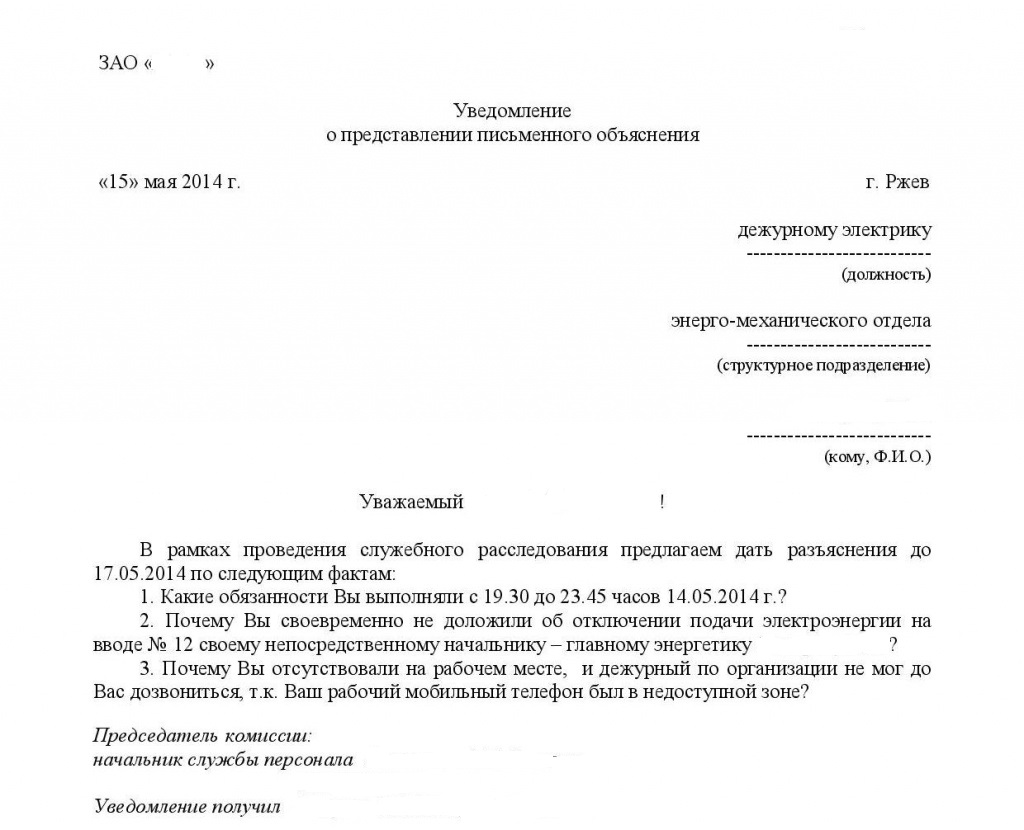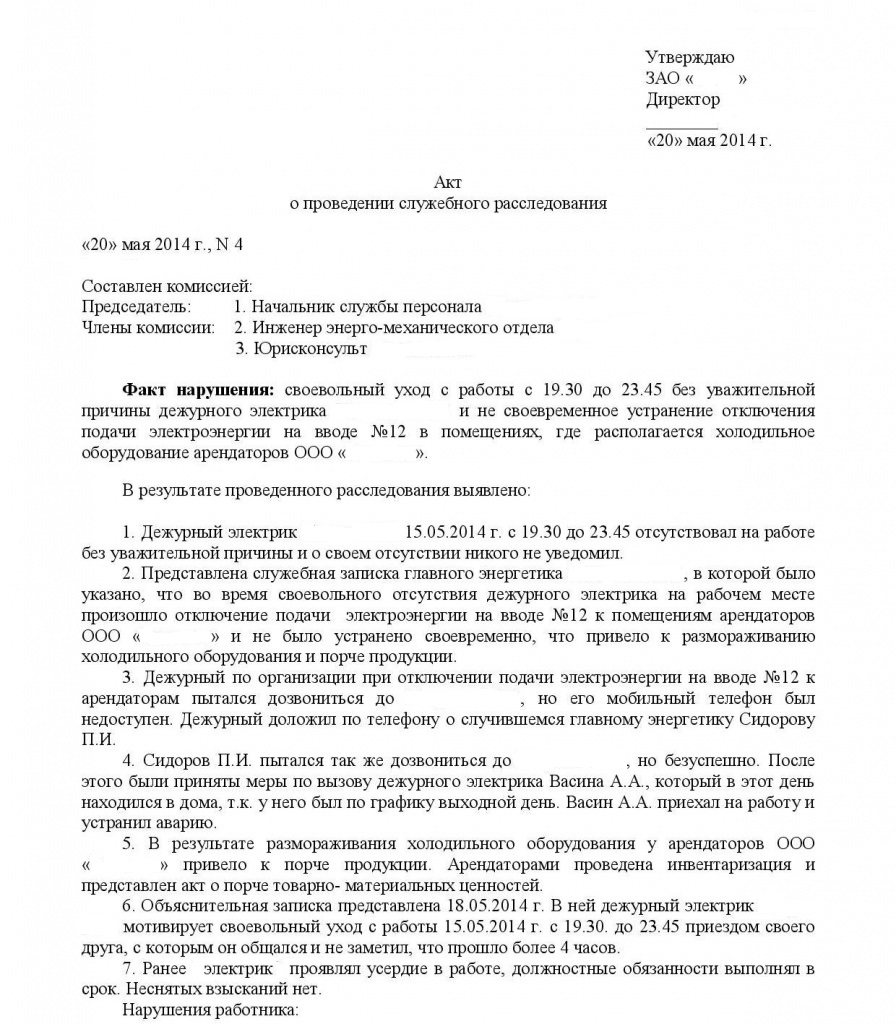The leaders of different companies often have to face the fact that their employees for various reasons violate different requirements of labor discipline or damage the property of the organization. In order to bring them to disciplinary action, an official investigation is conducted against the employee. A sample investigation report is located below. The document contains information on what results were obtained by the commission members. The main purpose of the procedure is to study all the circumstances relevant to a particular event.
The nuances of the investigation
An internal investigation is a mandatory process in the TC. It is carried out before any disciplinary sanction is applied to the employee of the company or an order is issued, on the basis of which he must compensate the damage caused to the company.
If the procedure is carried out in relation to municipal and state employees, as well as employees of law enforcement agencies, then it is called an internal audit.

When is it held?
An official investigation against an employee is necessarily carried out in case of various violations.
Such violations include truancy, material damage to the company or abuse of authority.
Clearance truant
On the basis of the Labor Code, truancy is a situation where an employee of a company is absent from the workplace for more than 4 consecutive hours without a good reason. Most often, employers use reprimands for such a violation, but if absenteeism has caused the company some damage, then even dismissal is allowed.
But in order to terminate the employment contract with the employee, it is necessary to first carry out some measures, the main purpose of which is to clarify the circumstances of the violation. This requires an internal investigation into the employee.
Damage to the company
In this situation, it is important to correctly identify the culprit. For this, all circumstances of such an event must be studied. This includes situations where a cash shortage is detected, the intentional theft of money or property, damage to property or other events.
Often, under such conditions, the management of a company is forced to use the help of independent appraisers and experts.
Abuse of authority
Such a disciplinary violation is considered significant enough. Under such conditions, the employee of the company performs actions that are not provided for by his job description. In this case, an investigation is conducted to determine what benefit the employee received from his actions. Often, an audit is required at all to find out exactly what damage was caused to the company.
Additionally, the head of each organization can independently determine in what situation it is advisable to use the investigation to obtain this or that information.

Principles of Procedure
Typically, organizations establish in their accounting policies a special provision for conducting internal investigations. It is on the basis of this document that this procedure is carried out. During its implementation, it is required to adhere to the following principles:
- objectivity, since members of the commission should not be interested in the result of the audit, as well as all actions taken should be impartial;
- innocence, since it is not allowed to blame a particular citizen in any event until the company management has evidence of his guilt or involvement;
- legality, which consists in the fact that all actions should be based on the requirements of the law, therefore it is not allowed to violate the law by any measures.
If the employee of the company in relation to which this investigation is conducted is sure that his rights or interests are violated by the management of the company, he can draw up a complaint to the prosecutor's office or labor inspectorate. If he is prosecuted without first conducting an investigation, he may seek help from state authorities or the court.
How is the process performed?
An internal investigation is considered a fairly simple and straightforward process. It is initiated by the head of a particular enterprise. To do this, the following actions are performed:
- the director of the company is notified that a particular employee has committed a disciplinary offense or that there are suspicions that it was he who inflicted certain damage on the property of the organization;
- an order is issued by the head of the company to initiate an investigation;
- all other actions must be performed within one month;
- a special commission is formed to investigate, and usually members of this collegial body are company security specialists or internal auditors;
- all elected members of the commission should be impartial and objective;
- a written explanatory is requested from the employee, which must be drawn up by the citizen within two days from the receipt of the notification;
- if it turns out that the citizen really had good reasons for the commission of an act, then he is not held accountable;
- if there are no valid grounds for such an event, then different punitive measures presented by a disciplinary sanction are applied to the employee;
- at the end of the procedure, an investigation report is drawn up.
Before making a decision, the head of the company must ask the employee for an explanation in the course of the internal investigation. A sample of such an order is handed over to the specialist for signature.

Rules for creating a commission
Mandatory official investigation at work is carried out by a special collegial body. It is created by the head of the organization, taking into account the following nuances:
- exclusively employees of the company who are not interested in the results of the inspection are selected for this;
- large companies have special services whose specialists are engaged in such inspections;
- in small organizations, a commission is usually created of personnel officers;
- the commission should include at least three citizens;
- To create it, an order must be issued by the head of the company, which includes the name and position of all members of the commission, as well as the purpose of its creation, the date of formation and validity;
- the order lists the powers vested in the selected company specialists.
It is the commission members who are engaged in an official investigation into the employee. A sample verification act is located in the article below. It contains information about what the results of this process are. Data on all participants in the investigation is entered in the same document.

What does the commission do?
Under the Labor Code, an internal investigation should be conducted only by members of the commission who have been selected by the head of the firm. This collegial body deals with the following tasks:
- identification of all circumstances that led to a particular event;
- determination of the place and time of the offense by the employee of the company;
- detection of a method of violation of the organization’s work schedule;
- calculation of the amount of damage caused to the company by the employee of the enterprise;
- identification of all persons who are responsible for a particular event;
- preparation of evidence of guilt of citizens, as well as establishing its degree for each employee of the enterprise, if there are several perpetrators;
- identification of the reasons contributing to such a violation;
- preparation and storage of documents related to this investigation;
- request from the employee explanatory.
It is allowed to form a commission even provided that the company has not actually suffered material damage. In small firms, such a collegial body does not operate constantly, so its work is resumed only when the appropriate need arises for conducting an internal investigation regarding the employee. A sample certificate of the audit can be developed by each company independently, after which the form is fixed in the accounting documentation.

Rules for preparing evidence
There is no information in the TC about the correct procedure and deadline for conducting an internal investigation, so this procedure can vary significantly in different situations. The rules for implementing this process are usually enshrined in the company's internal regulatory documents. To do this, management issues appropriate orders, instructions or regulations.
Members of the commission receive the right to interview company employees or study all documents. It is allowed to attract not only employees of the enterprise, but also third parties who are not interested in the results of the investigation. Usually this decision is made if the employees of the organization do not have the necessary knowledge to study the documents.
Auditors, appraisers, medical workers, lawyers, engineers, as well as other specialists may be involved in the investigation. To obtain the necessary evidence, the following actions are performed:
- Studying the accounting and accounting documents of the company;
- requested papers are requested from banks or other organizations that are counterparties to the firm;
- testimonies of witnesses and colleagues are made out in writing.
All acts, certificates, notes or other documents are attached to the case in the form of evidence.
How is an employee explaining requested?
Employees of the company who are suspected of committing any offense must make an explanatory note. It is requested by the management of the company or members of the commission.
An explanatory note must be given before the end of the investigation and the issuance of an order in which the employee is brought to disciplinary action. The features of this document include:
- the employee is given only two days to compile an explanatory note;
- it is formed in free form and in writing;
- the requirement to draw up a note is transferred to the employee against signature;
- if a citizen refuses to draw up this document, then the management draws up an appropriate act on refusal to provide explanations, which is signed by all members of the commission.
An explanatory statement is necessarily requested as part of an internal investigation regarding the employee. A sample requirement for its preparation can be studied below.

Rules for drawing up an act
At the end of the investigation, the commission will certainly prepare an appropriate act containing the results of this process. The rules for its formation include:
- the text indicates what illegal actions were committed by an employee of the enterprise;
- The circumstances preceding the violation are listed;
- damage to the company is given;
- the amount of damage is indicated;
- lists all the culprits and their degree of guilt;
- it prescribes which punitive measures are optimal for all perpetrators;
- recommendations are given to avoid similar events in the future.
The act must be signed by all members of the commission. It is allowed that any member of the commission refuse to sign this document if he has his own opinion on a specific situation. In this case, they form a separate documentation, which sets out his opinion. Other documents that are evidence are attached to it.
If an employee of the company caused material damage to the company, an inventory is carried out to determine how much to recover from the culprit. A well-written inventory is attached to the conclusion. According to Art. 193 of the Customs Code, an investigation is conducted within one place from the moment a specific violation is discovered. Usually this period is prescribed in the order of the head of the company.
After the end of the process, an act is drawn up in which the conclusion of the official investigation is given. A sample of this act can be studied below.

Conclusion
An internal investigation is conducted against employees who are suspected of any material offenses. The procedure is performed only by members of a special commission, which is formed by order of the head of the company. The process is to study numerous documentation.
Based on the results of the audit, a special conclusion is formed in which the guilty persons and the penalties applied to them are registered. This document is signed by all members of the commission. Based on the investigation, the employee is held accountable.
